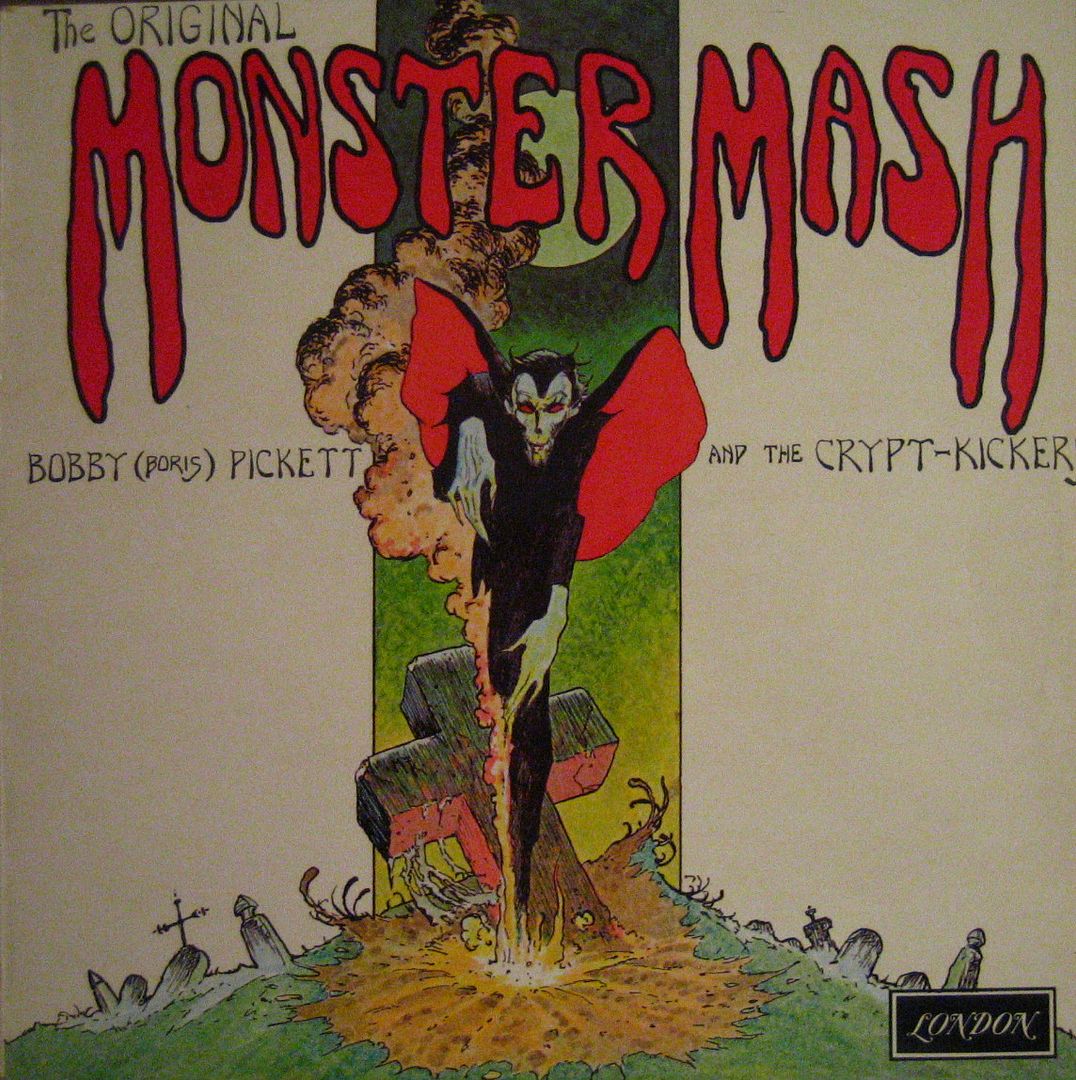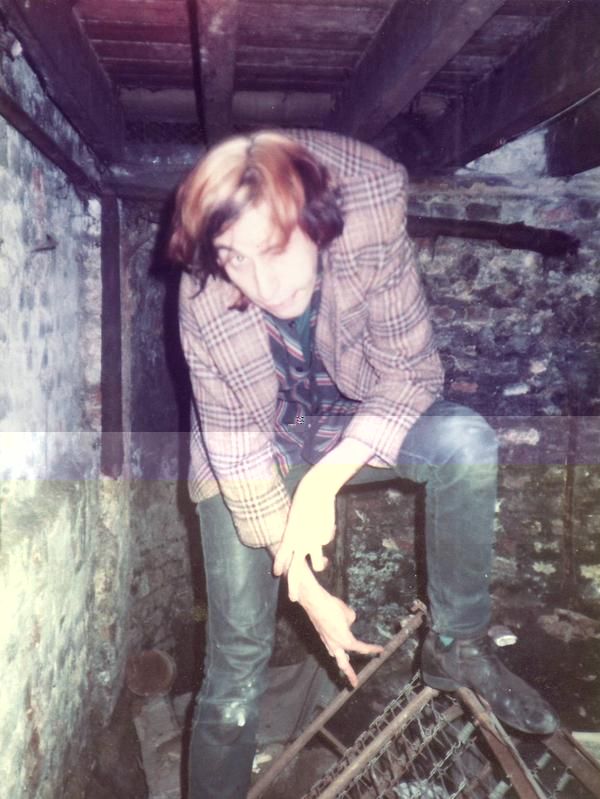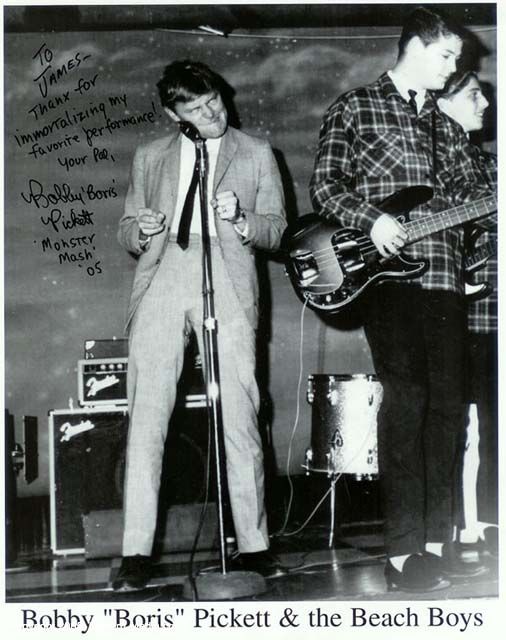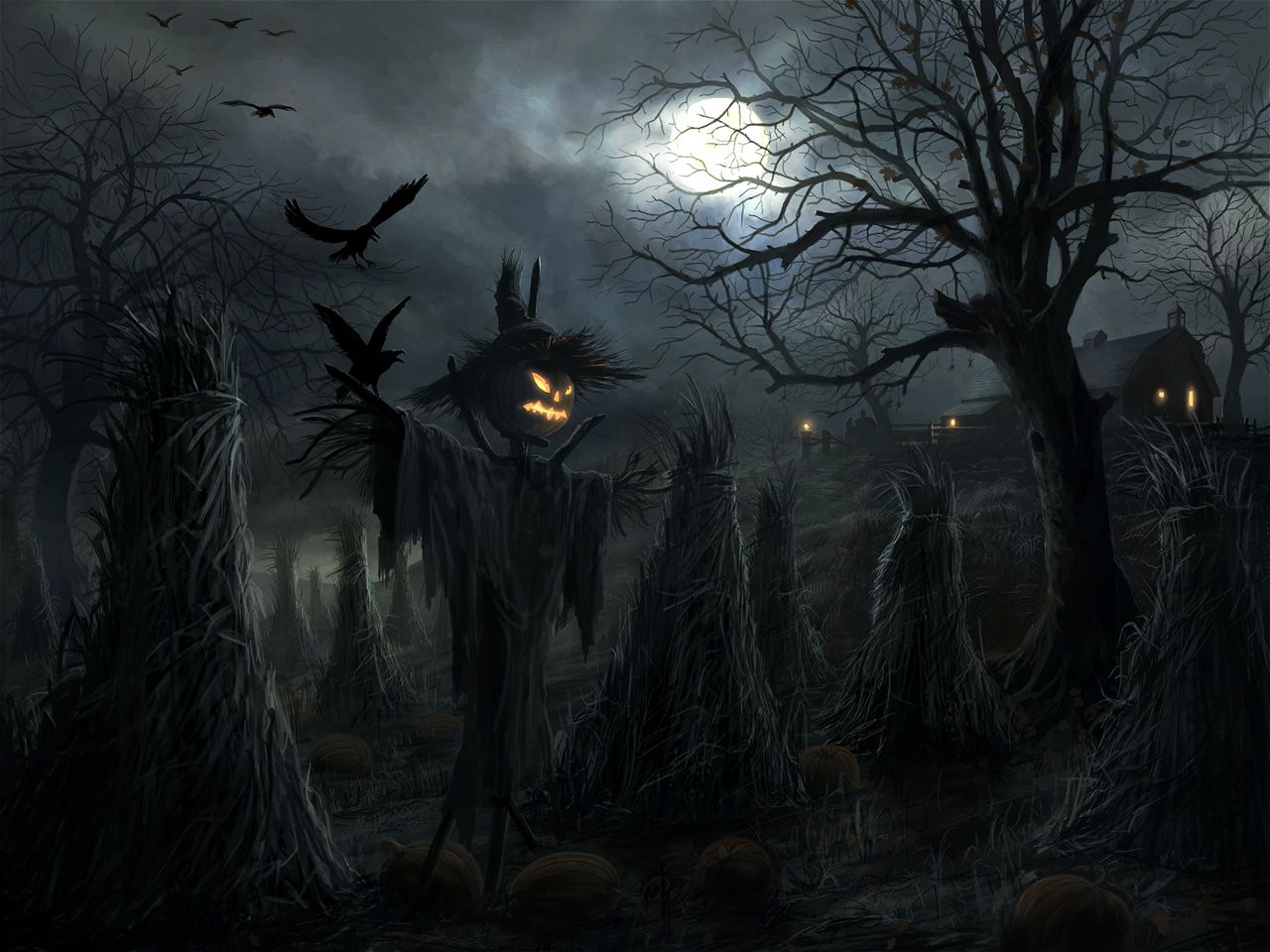

Monster Mash / Graveyard Shift / Blood Bank Blues / Rabian The Fiendish Idol / Monster Holiday
Tracks originally recorded in 1962, this collection of ‘Boris’ Pickett material was released in the UK on LP form eleven years later courtesy of London Records. Uploaded this LP tonight for all the ghoul’s that happen to be browsing the KYPP site this Halloween and also I must dedicate this whole post to Igor lookalike Bob Short formally of Blood And Roses.

Enjoy some lo-fi ‘stereo altered’ mono tracks from the Crypt Kickers. Back to the punk crash bang wallop next post.
Text and photo below of Pickett performing at a very early Beach Boys performance (by the look of it) ripped from those zombies at mojo4music.com, Halloween text ripped from the dark side.

How did it feel to be Bobby Pickett whenever October rolled around? The eleven-month wait for the coffin lid of your career to creak open and release your one cobwebbed hit. A hit resistant to each decade’s trends, whether Bee Gees or Nirvana or Coldplay. A hit that sold over four million copies. That must’ve felt pretty good, royalty check-wise. But year after year, to be on stage wearing a blood-smeared lab coat and singing in a hammy Karloff accent about “Dracula and his son?” That must’ve gotten old.
Pickett kept a good sense of humour about it, though. He called himself “the Guy Lombardo of Halloween.” He welcomed visitors to his website with: “Bobby ‘Boris’ Pickett is available year round and can be dug up to appear and sing a medley of his hit.”
Pickett never wanted to be a singer. When he moved to Hollywood in the early 1960s, it was to become an actor. His resumé included a knack for impersonations – the best of which was horrormeister Boris Karloff.
As Bobby hustled for acting jobs, he picked up extra cash on weekends singing at an Italian restaurant with a group called the Cordials. One of the tunes they covered was Little Darlin’ by the Diamonds. For a lark, in the middle of the song, Pickett recited a monologue in the Karloff voice. Audiences loved it. So much so that fellow band member Lenny Capizzi convinced Bobby that they should write a rock’n’roll song about monsters.
Pickett recalled, “We wrote about a monster who gets up off his gurney and does the latest dance craze, which I thought was the Twist. Lenny said, ‘The Mashed Potato’ is number one.’ So we called it ‘The Monster Mashed Potato.’ We shortened it later, but that was the original title.”
Pickett and Capizzi finished the song in two hours, then cut it with producer Gary Paxton – of Alley-Oop fame – and a backing band, dubbed The Crypt Kickers, that included a young pianist named Leon Russell. Eight weeks later, the song was Number 1 on the Billboard singles chart. It was October 1962, the height of the Cuban Missile Crisis. “It relieved people of the tension,” Pickett reckoned.
The spooky smash proved a perennial, charting again in 1970 and 1973, and getting steady airplay every October. Pickett had a #29 hit with the Christmas follow-up, Monsters’ Holiday, but later singles like Monster Swim, It’s Alive and Monster Rap failed to scare up any action. As for his acting career, it peaked with a low-budget cult film called, appropriately, Frankenstein Sings!
Pickett died in April 2007 at the age of 69, but he stayed active until his final months. An environmentalist, he even wrote two spin-off tunes – Monster Slash, protesting against the exploitation of the rainforests, and the global warming-related Climate Mash, which envisioned Bush and Cheney getting down with zombies and vampires at a party thrown by Exxon Mobil.
Pickett’s official website still peddles souvenirs, including a posthumous autobiography called Monster Mash: Half Dead in Hollywood. His myspace page boasts friends from Weird Al to Rob Zombie to Elvira, Mistress of the Dark.
In the end, his song was the trick that kept treating. As Pickett said in 2006, “Monster Mash paid my rent for forty-four years.”

Halloween history and traditions
Halloween, celebrated each year on October 31, is a mix of ancient Celtic practices, Catholic and Roman religious rituals and European folk traditions that blended together over time to create the holiday we know today. Straddling the line between fall and winter, plenty and paucity and life and death, Halloween is a time of celebration and superstition. Halloween has long been thought of as a day when the dead can return to the earth, and ancient Celts would light bonfires and wear costumes to ward off these roaming ghosts. The Celtic holiday of Samhain, the Catholic Hallowmas period of All Saints’ Day and All Souls’ Day and the Roman festival of Feralia all influenced the modern holiday of Halloween. In the 19th century, Halloween began to lose its religious connotation, becoming a more secular community-based children’s holiday. Although the superstitions and beliefs surrounding Halloween may have evolved over the years, as the days grow shorter and the nights get colder, people can still look forward to parades, costumes and sweet treats to usher in the winter season.
Halloween’s origins date back to the ancient Celtic festival of Samhain.
The Celts, who lived 2,000 years ago in the area that is now Ireland, the United Kingdom, and northern France, celebrated their new year on November 1. This day marked the end of summer and the harvest and the beginning of the dark, cold winter, a time of year that was often associated with human death. Celts believed that on the night before the new year, the boundary between the worlds of the living and the dead became blurred. On the night of October 31, they celebrated Samhain, when it was believed that the ghosts of the dead returned to earth. In addition to causing trouble and damaging crops, Celts thought that the presence of the otherworldly spirits made it easier for the Druids, or Celtic priests, to make predictions about the future. For a people entirely dependent on the volatile natural world, these prophecies were an important source of comfort and direction during the long, dark winter.
To commemorate the event, Druids built huge sacred bonfires, where the people gathered to burn crops and animals as sacrifices to the Celtic deities.
During the celebration, the Celts wore costumes, typically consisting of animal heads and skins, and attempted to tell each other’s fortunes. When the celebration was over, they re-lit their hearth fires, which they had extinguished earlier that evening, from the sacred bonfire to help protect them during the coming winter.
By A.D. 43, Romans had conquered the majority of Celtic territory. In the course of the four hundred years that they ruled the Celtic lands, two festivals of Roman origin were combined with the traditional Celtic celebration of Samhain.
The first was Feralia, a day in late October when the Romans traditionally commemorated the passing of the dead. The second was a day to honor Pomona, the Roman goddess of fruit and trees. The symbol of Pomona is the apple and the incorporation of this celebration into Samhain probably explains the tradition of “bobbing” for apples that is practiced today on Halloween.
By the 800s, the influence of Christianity had spread into Celtic lands. In the seventh century, Pope Boniface IV designated November 1 All Saints’ Day, a time to honor saints and martyrs. It is widely believed today that the pope was attempting to replace the Celtic festival of the dead with a related, but church-sanctioned holiday. The celebration was also called All-hallows or All-hallowmas (from Middle English Alholowmesse meaning All Saints’ Day) and the night before it, the night of Samhain, began to be called All-hallows Eve and, eventually, Halloween. Even later, in A.D. 1000, the church would make November 2 All Souls’ Day, a day to honor the dead. It was celebrated similarly to Samhain, with big bonfires, parades, and dressing up in costumes as saints, angels, and devils. Together, the three celebrations, the eve of All Saints’, All Saints’, and All Souls’, were called Hallowmas.
Halloween has always been a holiday filled with mystery, magic and superstition. It began as a Celtic end-of-summer festival during which people felt especially close to deceased relatives and friends. For these friendly spirits, they set places at the dinner table, left treats on doorsteps and along the side of the road and lit candles to help loved ones find their way back to the spirit world.
Today’s Halloween ghosts are often depicted as more fearsome and malevolent, and our customs and superstitions are scarier too. We avoid crossing paths with black cats, afraid that they might bring us bad luck. This idea has its roots in the Middle Ages, when many people believed that witches avoided detection by turning themselves into cats. We try not to walk under ladders for the same reason. This superstition may have come from the ancient Egyptians, who believed that triangles were sacred; it also may have something to do with the fact that walking under a leaning ladder tends to be fairly unsafe. And around Halloween, especially, we try to avoid breaking mirrors, stepping on cracks in the road or spilling salt.
But what about the Halloween traditions and beliefs that today’s trick-or-treaters have forgotten all about? Many of these obsolete rituals focused on the future instead of the past and the living instead of the dead. In particular, many had to do with helping young women identify their future husbands and reassuring them that they would someday, with luck, by next Halloween, be married.
In 18th-century Ireland, a matchmaking cook might bury a ring in her mashed potatoes on Halloween night, hoping to bring true love to the diner who found it. In Scotland, fortune-tellers recommended that an eligible young woman name a hazelnut for each of her suitors and then toss the nuts into the fireplace. The nut that burned to ashes rather than popping or exploding, the story went, represented the girl’s future husband. (In some versions of this legend, confusingly, the opposite was true: The nut that burned away symbolized a love that would not last.) Another tale had it that if a young woman ate a sugary concoction made out of walnuts, hazelnuts and nutmeg before bed on Halloween night, she would dream about her future husband. Young women tossed apple-peels over their shoulders, hoping that the peels would fall on the floor in the shape of their future husbands’ initials; tried to learn about their futures by peering at egg yolks floating in a bowl of water; and stood in front of mirrors in darkened rooms, holding candles and looking over their shoulders for their husbands’ faces.
Other rituals were more competitive. At some Halloween parties, the first guest to find a burr on a chestnut-hunt would be the first to marry; at others, the first successful apple-bobber would be the first down the aisle.
Another day with connections to Halloween is Guy Fawkes Day, celebrated on November 5. Guy Fawkes was a Roman Catholic who planned to blow up the Protestant House of Parliament on November 5, 1606; luckily for the House, he was apprehended and executed. Afterwards, the anniversary of the day was celebrated by building straw effigies, entreating passersby for “a penny for the Guy”, and finally burning “the Guys” in bonfires.


bob
November 1, 2009 at 1:32 amSee, that photo of me… I was using that exact same pose when the neighbourhood kids came round for trick or treat. I live in “the scary house” according to local children. Yes! My favourite costume this year was when an eight year old came to the door in a pack. The mummys, witches, vampire were easy to spot, but I had to ask her what she was. “I’m a murdered school girl” was her response. She earned herself extra lollies for that! Last night, the Dead Rabids, my current band, played a halloween party in a makeshift graveyard with smoke machines, ghosts in the trees, the whole nine yards. In case anyone is interested, songs included “Jesus”, “Paradise”, “Love Under Will” and a finale of “Louie Louie” and “Spit on your Grave”. I wish all you guys could have been there! Happy Halloween everybody.
Graham Burnett
November 1, 2009 at 8:53 pmBack in the early 1960’s I used to go round to a friends house who had this excellent Spike Jones and His City Slickers ‘horror’ LP which we always seemed to be playing, this was maybe a couple of years before we ‘grew up’ and got into ‘proper’ music like Led Zeppelin, I’d forgotten all about this record until I saw this post, can’t remember the name of it, but thinking back it may well have had cover artwork by Jack Davies (of Mad Magazine fame), and contained these real cornball ‘Dracula’ and Peter Lorre parodies, which we found hilarious at the time… This friend also used to play ‘Ernie the fastest milkman in the West’ constantly, so shows how long ago/how young we were, but would be great to hear the Spike Jones album again, maybe an uplaod for next Halloween – Nic is bound to know what the record actually is… 🙂
Graham Burnett
November 1, 2009 at 8:55 pmJust remembered – same friend also had a ‘Hammer Horror’ LP which IIRC featured Christopher Lee doing spoken word highlights from the hammer Dracula films…